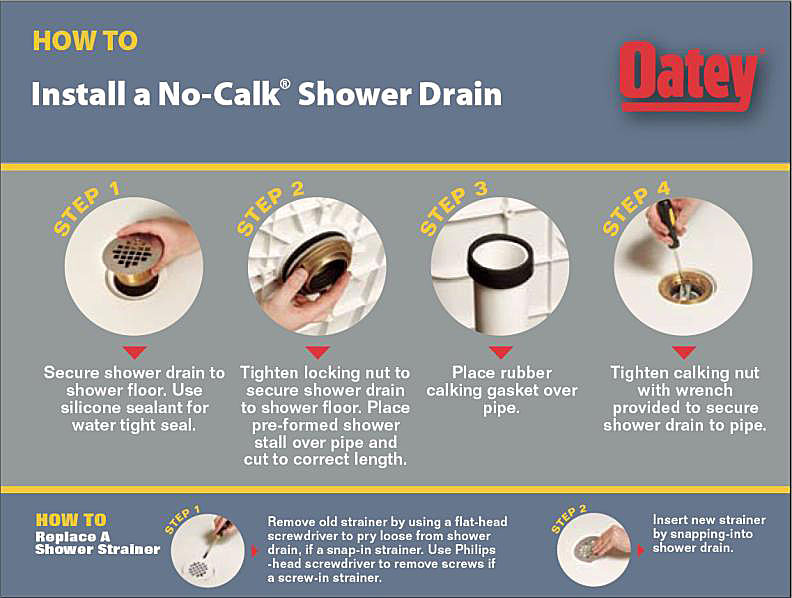Oatey No Caulk Flashing Installation
Exclusive 1-piece construction insures a positive leakproof installation every time. Omnisphere Challenge Code Keygen Bandicam. Oatey No-Caulk Flashing With Galvanized Steel Base - 11854. Installation Supplies. Water Fountains & Coolers. Drains, Cleanouts & Accessories. Shop More Plumbing. Download Hack Watchguard License Keys more. Oatey Flex-Flash™ No-Calk Roof Flashing 10 x 13.25 in.

I am installing a Sterling Accord shower in my basement and will be using an Oatey no caulk brass shower drain. This is my first shower install, so I'm trying to figure at what height to cut the 2' PVC drain pipe. I will be putting mortar piles under the shower base (as described in one of Terry's posts) so I'm thinking of leaving the the PVC pipe a little high and then squishing the base down until the top of the PVC pipe is about at the correct height in relation to the brass drain body. My question is how exact do I need to get the height of the PVC drain pipe? When it's all said and done, does the bottom of the rubber compression gasket need to be seated/touching the bottom shelf/flange of the drain body? I'm not sure if I'm making sense here, so I'll ask another way: will the compression nut push the rubber gasket further down the PVC pipe until it seats on the bottom of the brass drain body -or- will the rubber gasket compress around the PVC pipe and stay in place by friction? Any advice is appreciated.
Click to expand.Thanks Terry! That answers my question. And thanks for the comment on the mortar not lifting up the pan as I was considering doing exactly that to make the drain be at the right height in relation to the PVC pipe. I will push the pan down to the floor, making sure it is level. Just two more quick questions -- do I need thread lock on either the locking nut under the shower or the caulking nut on top?
And if I use silicone under the drain body flange is it possible to ever remove this drain if I should need to in the future? The part I've been concerned with is getting the riser height correct and doing this mortar bed/piles under the pan correctly. An old thread on these forums had a guy who said he didn't account for the thickness of the mortar bed when he cut his riser and his riser ended up about a 1/4' too short.so that got me thinking that I didn't want to have that problem. I think Terry's comment about mortar not 'lifting up the pan' really helped, though. I'll just make sure the pan squishes all the way to the floor. I guess if I put too much mortar and the pan won't squish to the floor, I'll pull it up and remove some mortar and do it again until it goes go to the floor.
Your mortar should be just 8-12 piles, not a slab. Set your pan and shim the 'feet' if needed to level it first.
A dab of construction adhesive to hold the shims in place on the floor prevents them from moving when you set your piles of mortar later. Mix your mortar stiff to keep shrinkage minimal as it sets.
If you have an extra pair of hands, they can help to set the pan straight down into the mortar. Squish the pan straight down until it is on it's solid on it's feet and walk away until the mortar sets. I set the shower base in mortar as discussed above, hooked up the no caulk drain and tightened the compression nut down on the drain so I could do a simple leak test while the mortar set up. I then waited 24 hours. The good news: the drain doesn't appear to have any leaks and the shower floor feels nice and solid. The bad news: I noticed a bulge near the front of the shower floor.
I guess the first question is what in the heck did I do wrong? There's no mortar underneath the shower at that point. I can reach my hand under there and feel the curve of the bulge and there's no mortar there. See my attached picture of the mortar piles. Second question - is there any suggestions on how to fix? Would a heat gun and some pressure help these bulges pop back into place? Any ideas at all?
Has anyone seen this before? The bulge seems to run most of the length of the threshold but is somewhat flatter in the middle. Applied Medicine And Surgery In Dentistry Pdf.
No-Caulk 2 in. Galvanized Steel Roof Flashing Made from rust-resistant, stamped, 24-gauge steel, the Oatey No-Caulk 2 in. Galvanized Steel Roof Flashing offers rugged durability. The flashing is designed for roof pitches from 0 to 40 degrees or up to a 10/12 pitch. This flashing is rated to withstand up to 180 degrees Fahrenheit continuous heat and is approved for Type B installations.